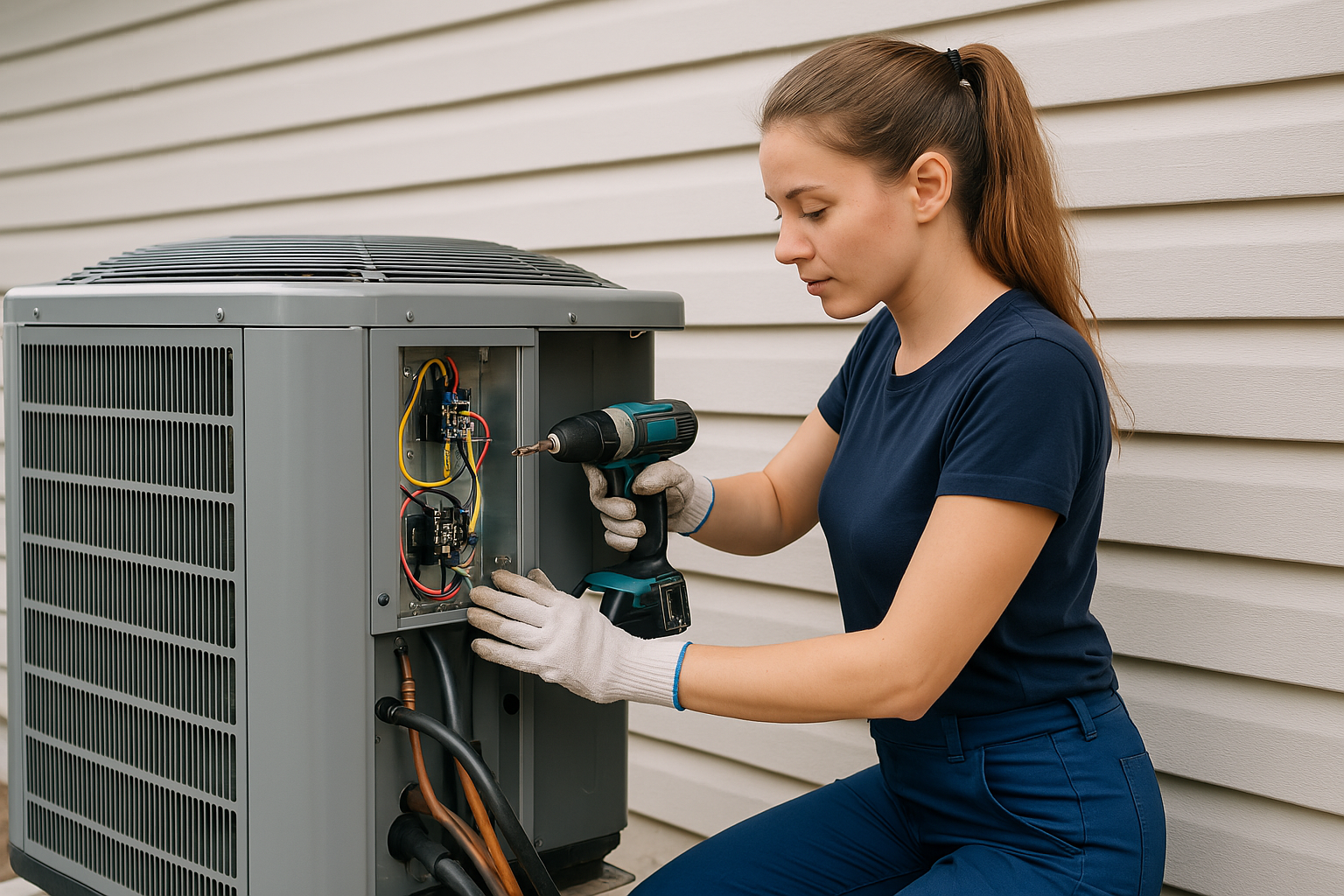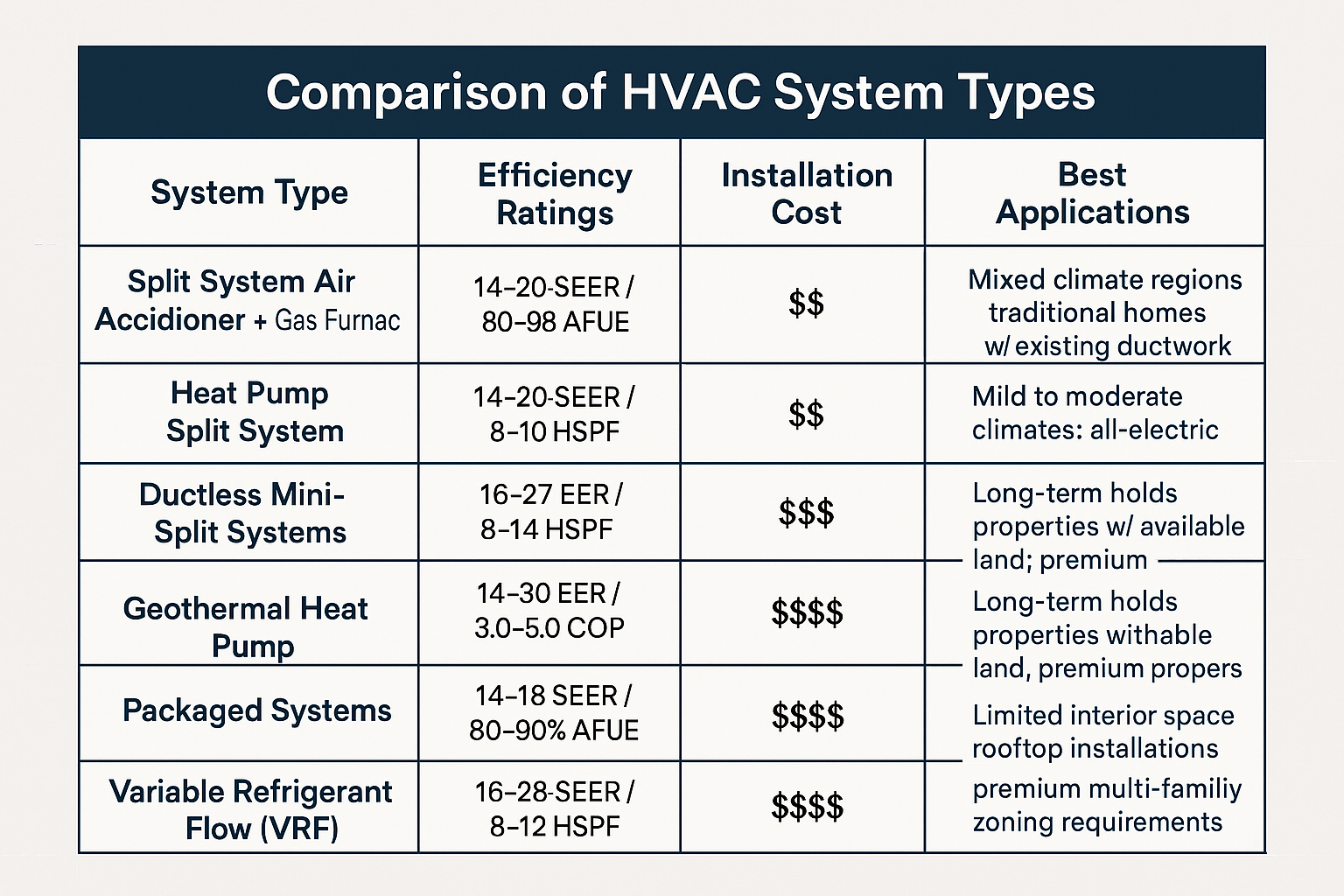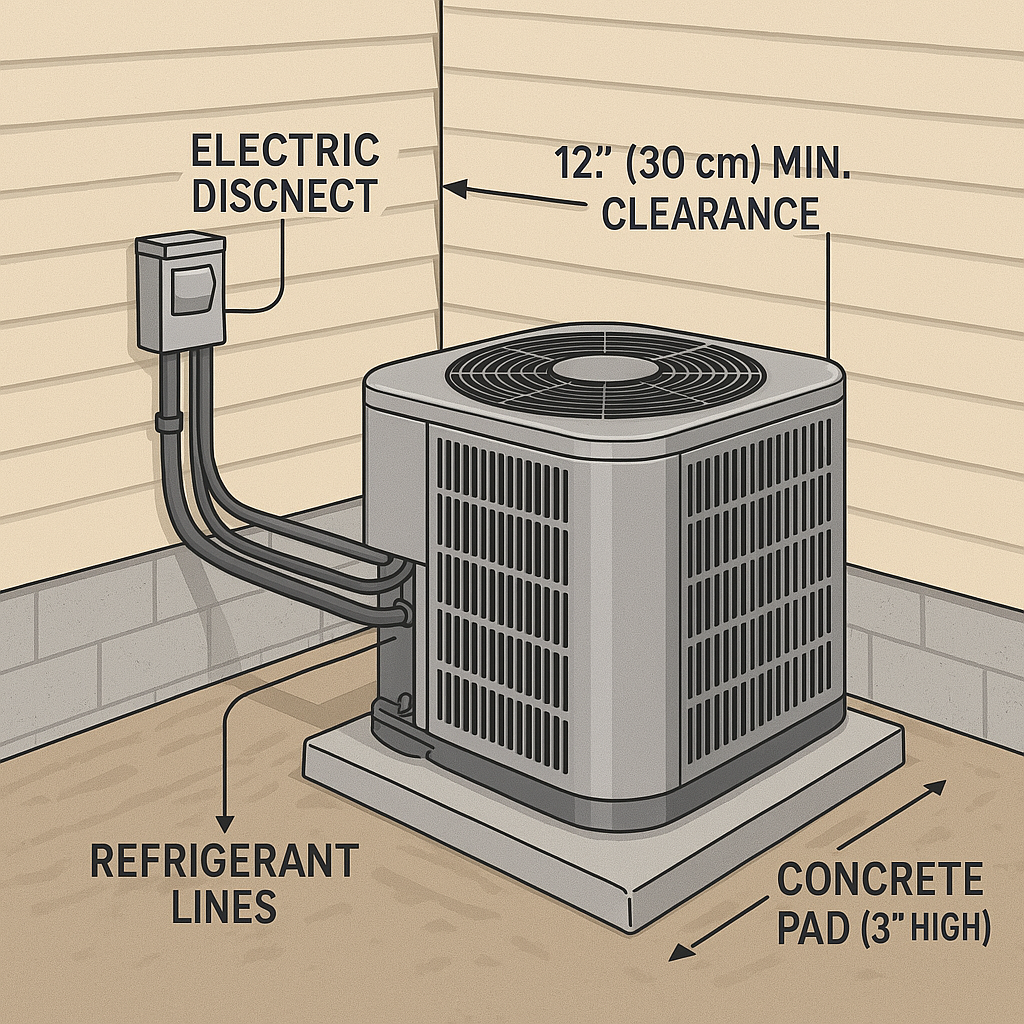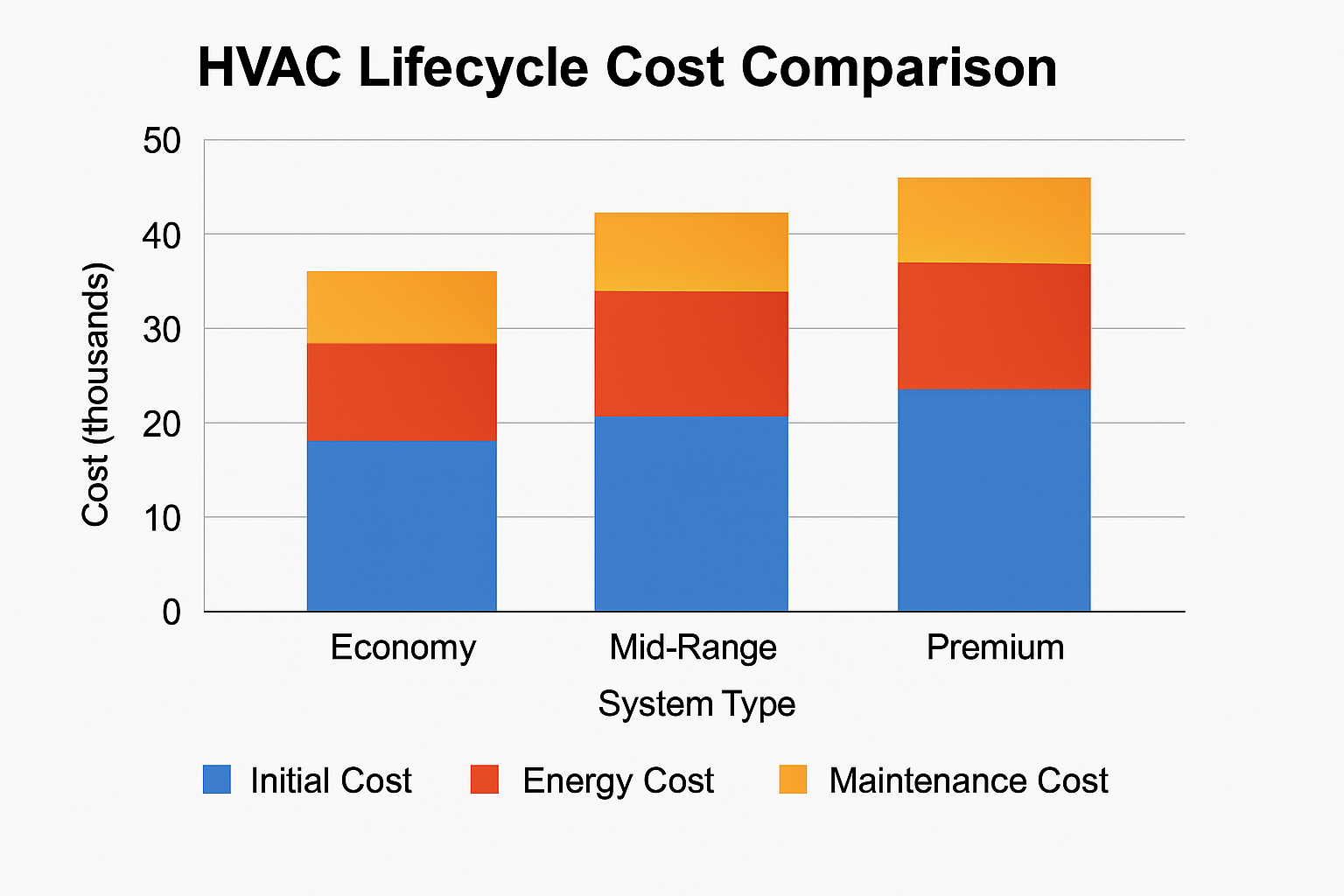
Check out our app!
Explore more features on mobile.
HVAC Installation: Strategic Implementation Guide for Real Estate Investors
Heating, Ventilation, and Air Conditioning (HVAC) systems represent one of the most significant mechanical investments in any property, directly impacting occupant comfort, energy consumption, and long-term maintenance costs. For real estate investors, HVAC decisions have far-reaching implications for property marketability, operational expenses, and overall return on investment. According to the Department of Energy, HVAC systems account for approximately 40-60% of a building’s energy use, making their efficiency and performance critical to property economics.

[Image: Comparison of major HVAC system types with key components labeled]
Strategic HVAC Planning for Investment Properties
Effective HVAC planning requires a strategic approach that balances initial costs with long-term performance. The Air Conditioning Contractors of America (ACCA) emphasizes that proper system design and installation can reduce lifetime operating costs by 20-30% while extending equipment lifespan by 5-10 years.
Key strategic considerations for real estate investors include:
- Investment timeline alignment – Matching system quality and lifespan with intended holding period
- Regional climate factors – Prioritizing heating or cooling based on local weather patterns
- Energy cost projections – Considering utility rate trends when evaluating efficiency options
- Property type and usage patterns – Tailoring systems to occupancy characteristics and needs
- Maintenance and serviceability – Planning for system accessibility and ongoing care requirements
Load Calculation Importance
According to ENERGY STAR, approximately 50% of all HVAC systems are improperly sized, leading to comfort issues, excessive energy consumption, and premature equipment failure. Proper load calculation involves:
- Manual J load calculation – Industry-standard method for determining heating and cooling loads
- Building envelope analysis – Evaluating insulation levels, windows, air leakage, and thermal characteristics
- Room-by-room assessment – Calculating specific needs for different spaces within the property
- Peak load determination – Designing for the most demanding conditions while considering diversity factors
- Latent vs. sensible load balance – Addressing both temperature and humidity control requirements
The National Institute of Building Sciences reports that right-sized systems typically cost 10-15% less to purchase while delivering 20-35% better lifetime efficiency compared to oversized equipment.
Distribution System Planning
The Air Diffusion Council notes that ductwork design and installation have as much impact on system performance as equipment selection. Strategic distribution planning includes:
- Manual D duct design – Engineered sizing for proper airflow throughout the system
- Zoning considerations – Evaluating the need for separate temperature control areas
- Space allocation requirements – Ensuring adequate room for properly sized ductwork
- Noise control strategies – Minimizing sound transmission through the distribution system
- Return air path planning – Ensuring adequate air circulation throughout the property
Research by the National Renewable Energy Laboratory shows that poorly designed distribution systems can reduce overall HVAC efficiency by 25-40%, effectively negating the benefits of high-efficiency equipment.
HVAC System Types and Selection Criteria
The HVAC market offers numerous system types, each with distinct advantages and limitations. According to the American Society of Heating, Refrigerating and Air-Conditioning Engineers (ASHRAE), proper system selection should account for climate zone, building characteristics, and specific project requirements.

[Image: Side-by-side comparison of major HVAC system types with performance metrics]
| System Type | Typical Efficiency Range | Relative Installation Cost | Best Investment Application |
|---|---|---|---|
| Split System Air Conditioner with Gas Furnace | 14-20 SEER / 80-98% AFUE | $$ (Moderate) | Mixed climate regions; traditional homes with existing ductwork |
| Heat Pump Split System | 14-20 SEER / 8-10 HSPF | $$ (Moderate) | Mild to moderate climates; all-electric properties |
| Ductless Mini-Split Systems | 16-27 SEER / 8-14 HSPF | $$$ (Moderate-High) | Multi-family properties; additions; properties without ductwork |
| Geothermal Heat Pump | 14-30 EER / 3.0-5.0 COP | $$$$ (High) | Long-term holds; properties with available land; premium properties |
| Packaged Systems | 14-18 SEER / 80-90% AFUE | $$ (Moderate) | Limited interior space; rooftop installations; commercial properties |
| Variable Refrigerant Flow (VRF) | 16-28 SEER / 8-12 HSPF | $$$$ (High) | Mixed-use properties; premium multi-family; zoning requirements |
| Hybrid Dual-Fuel Systems | 14-20 SEER / 80-98% AFUE | $$$ (Moderate-High) | Cold climates with significant heating loads; volatile energy markets |
Equipment Efficiency Considerations
The Department of Energy establishes minimum efficiency standards for HVAC equipment, with ratings that vary by system type:
- Air Conditioners and Heat Pumps (Cooling) – Measured by Seasonal Energy Efficiency Ratio (SEER):
- Minimum legal requirement: 14 SEER in northern states, 15 SEER in southern states
- Standard efficiency: 15-16 SEER
- High efficiency: 17-19 SEER
- Premium efficiency: 20+ SEER
- Heat Pumps (Heating) – Measured by Heating Seasonal Performance Factor (HSPF):
- Minimum legal requirement: 8.2 HSPF
- Standard efficiency: 8.5-9.0 HSPF
- High efficiency: 9.0-10.0 HSPF
- Premium efficiency: 10.0+ HSPF
- Gas Furnaces – Measured by Annual Fuel Utilization Efficiency (AFUE):
- Minimum legal requirement: 80% AFUE (non-weatherized)
- Standard efficiency: 80-85% AFUE
- High efficiency: 90-95% AFUE
- Premium efficiency: 96-98% AFUE
Technology Features and Advancements
Modern HVAC systems offer numerous technological enhancements that impact both performance and investment value:
- Variable-speed technology – Compressors and fan motors that adjust output to match demand, improving efficiency and comfort
- Multi-stage operation – Systems that operate at different capacity levels based on conditions
- Smart thermostats and controls – Wi-Fi enabled devices offering remote operation and advanced programming
- Zoning capabilities – Systems allowing independent temperature control in different areas
- Air quality components – Enhanced filtration, UV purification, and humidity control options
Research by the National Association of Home Builders shows that smart thermostats and zone control systems are among the most desired technology features for home buyers, with 77% of buyers ranking these as either “essential” or “desirable” in new construction.
Professional Installation Considerations
The Environmental Protection Agency estimates that more than half of all HVAC systems perform below their rated efficiency due to improper installation. According to ACCA, professional installation quality directly impacts system efficiency, reliability, and lifespan.
Contractor Selection Criteria
The quality of your HVAC contractor significantly influences installation outcomes. Key qualification factors include:
- Licensing and certifications – Verifying proper state and local credentials
- NATE certification – North American Technician Excellence certification indicates superior training
- Manufacturer training – Specialized education for specific equipment brands
- Liability insurance and bonding – Protection against accidents and installation issues
- Design capabilities – Ability to perform Manual J, D, and S calculations
- Warranty offerings – Both manufacturer and workmanship guarantees
Equipment Placement and Spatial Requirements
Proper equipment placement affects both performance and maintenance accessibility:
- Clearance requirements – Maintaining manufacturer-specified access space around units
- Noise considerations – Locating equipment to minimize sound impact on living spaces
- Outdoor unit placement – Providing proper airflow, shade considerations, and protection from debris
- Indoor unit location – Centralizing air handlers for optimal distribution
- Service accessibility – Ensuring components can be easily maintained and replaced

[Image: Detailed installation guidelines showing proper equipment placement and connections]
Ductwork Installation Quality
The Department of Energy reports that typical duct systems lose 25-40% of heating and cooling energy due to leakage, poor insulation, and improper design. Quality installation includes:
- Proper sizing methodology – Following Manual D calculations for appropriate dimensions
- Sealing techniques – Using mastic, metal tape, or aerosol sealing for all connections
- Insulation requirements – R-6 to R-8 insulation for ducts in unconditioned spaces
- Support and hanging methods – Preventing sagging and maintaining proper airflow
- Return air design – Ensuring adequate pathways for air circulation
- Minimizing bends and restrictions – Maintaining smooth airflow throughout the system
Refrigerant Line Installation
For split systems, proper refrigerant line installation is critical for performance and reliability:
- Proper sizing – Following manufacturer specifications for line diameter
- Cleanliness protocols – Keeping lines free of contaminants during installation
- Brazing techniques – Using nitrogen purge to prevent oxide formation
- Insulation requirements – Proper coverage to prevent energy loss and condensation
- Pressure testing – Verifying system integrity before charging
- Correct refrigerant charge – Precise measurement to manufacturer specifications
Electrical Connections and Controls
Electrical installation quality affects both safety and system performance:
- Proper circuit sizing – Providing adequate electrical capacity for equipment
- Disconnect placement – Installing shutoffs according to code requirements
- Control wiring techniques – Low-voltage connections for thermostats and zone controls
- Safety device verification – Ensuring all protective features function correctly
- Grounding requirements – Proper electrical grounding for safety
- Control system setup – Correct programming of thermostats and automation systems
Commissioning and Performance Verification
ENERGY STAR recommends comprehensive system commissioning to ensure installed performance matches design expectations:
- Airflow measurement – Verifying proper cubic feet per minute (CFM) at registers
- System charging verification – Confirming correct refrigerant levels
- Static pressure testing – Measuring resistance through the distribution system
- Temperature differential verification – Confirming proper cooling and heating performance
- Control function testing – Ensuring thermostats and zoning systems operate correctly
- Performance documentation – Recording baseline measurements for future reference
Energy Efficiency and Regulatory Compliance
HVAC systems operate under increasingly stringent efficiency and environmental regulations. According to the U.S. Energy Information Administration, heating and cooling account for approximately 48% of energy use in typical U.S. homes, making efficiency improvements particularly impactful for operating costs.
Minimum Efficiency Standards
The Department of Energy establishes and periodically updates minimum efficiency requirements:
- Regional standards – Different minimum SEER and HSPF requirements by climate zone
- Implementation timeline – January 2023 transition to new efficiency metrics (SEER2, EER2, HSPF2)
- Equipment types covered – Air conditioners, heat pumps, furnaces, boilers, and other HVAC equipment
- Testing and certification requirements – Standardized procedures for rating equipment
- Enforcement mechanisms – Compliance verification through various regulatory channels
Building Code Requirements
Modern building energy codes establish requirements for HVAC system design and installation:
- International Energy Conservation Code (IECC) – Widely adopted baseline for energy performance
- ASHRAE Standard 90.1 – Technical standard referenced by many commercial codes
- Local amendments – City and state-specific modifications to model codes
- Ventilation standards – Requirements from ASHRAE Standard 62.1/62.2 for indoor air quality
- Documentation requirements – Records and verification needed for code compliance
Environmental Regulations
Refrigerant and environmental regulations continue to evolve with significant implications for HVAC systems:
- Refrigerant phasedowns – Transition from high-GWP refrigerants to lower-impact alternatives
- EPA Section 608 requirements – Technician certification and refrigerant handling protocols
- Leak detection and repair mandates – Requirements for commercial refrigeration and larger systems
- Equipment disposal regulations – Proper management of refrigerants during system retirement
- Future regulatory roadmap – Anticipated changes to refrigerant and efficiency requirements
Financial Incentives and Programs
Various programs offer financial support for energy-efficient HVAC investments:
- Federal tax credits – Available for qualifying high-efficiency equipment
- Utility rebate programs – Local incentives for efficiency upgrades
- Weatherization assistance – Programs for qualifying properties and owners
- Energy-efficient mortgages – Financing options that recognize efficiency investments
- ENERGY STAR certification – Recognition programs that enhance property value
The Database of State Incentives for Renewables & Efficiency (DSIRE) provides a comprehensive repository of available incentives by location, which can significantly impact the financial equation for HVAC investments.
Cost Analysis and ROI Calculations
HVAC investments require careful financial analysis that considers both initial costs and long-term operational impacts. According to the National Association of Home Builders, HVAC systems typically represent 7-10% of new construction costs and are among the most significant renovation expenditures for existing properties.
| System Component | Economy Grade | Mid-Range | Premium Grade |
|---|---|---|---|
| Central AC + Gas Furnace (3 ton) | $5,000-$7,000 | $7,500-$10,000 | $11,000-$15,000+ |
| Heat Pump Split System (3 ton) | $6,000-$8,000 | $8,500-$12,000 | $13,000-$18,000+ |
| Ductless Mini-Split (3 zones) | $5,000-$7,000 | $7,000-$10,000 | $10,000-$15,000+ |
| Geothermal Heat Pump | $15,000-$20,000 | $20,000-$30,000 | $30,000-$45,000+ |
| New Ductwork Installation | $2,000-$3,500 | $3,500-$5,000 | $5,000-$8,000+ |
| Zoning System Addition | $1,500-$2,500 | $2,500-$3,500 | $3,500-$5,000+ |
| Smart Thermostat | $150-$250 | $250-$400 | $400-$600+ |
Note: Costs represent national averages for installed equipment. Regional variations can be significant (±20%). Source: Home Advisor, HVAC.com, Fixr.com (2023 data)
Operational Cost Impacts
The Department of Energy provides data showing that HVAC operational costs vary significantly based on system efficiency:
- Air conditioning efficiency impact – Upgrading from 14 SEER to 18 SEER typically reduces cooling costs by 22-25%
- Gas furnace efficiency differences – 80% AFUE vs. 96% AFUE represents approximately 17-20% reduction in heating costs
- Heat pump performance factors – Modern heat pumps maintain efficiency at lower temperatures, expanding their practical application range
- Distribution system losses – Leaky, poorly insulated ductwork can waste 25-40% of heating and cooling energy
- Maintenance impact on efficiency – Regular maintenance preserves 5-10% of operating efficiency compared to neglected systems
Return on Investment Factors
Multiple factors influence the financial return on HVAC investments:
- Energy cost variability – Local utility rates significantly impact payback periods
- Climate demands – Usage patterns in different regions affect operational savings
- Installation quality premium – Higher-quality installation often delivers better efficiency than specified
- Maintenance cost differences – Premium equipment may require specialized service
- System longevity variations – Expected lifespan differences between economy and premium equipment
- Property value impact – Contribution to overall property marketability and appraisal value
Investment Perspective: Property Type Considerations
HVAC investment strategies vary by property type and investment horizon according to market research from the National Association of Realtors and Building Owners and Managers Association:
- Fix-and-flip properties: Focus on reliable, code-compliant systems with mid-range efficiency that appeal to broad market segments without overinvesting
- Long-term rental properties: Prioritize durability, low maintenance requirements, and energy efficiency that reduces operating costs
- Owner-occupied properties: Consider premium comfort features, zoning capabilities, and advanced filtration that enhance daily living experience
- Luxury properties: Include high-end systems with premium features, superior efficiency, and aesthetic integration that meets upscale market expectations
- Multi-family investments: Evaluate individual vs. central systems based on utility metering strategy and target tenant demographic
Lifecycle Cost Analysis
The American Society of Heating, Refrigerating and Air-Conditioning Engineers (ASHRAE) recommends lifecycle cost analysis that considers:
- Initial purchase and installation costs – Complete system price including equipment and labor
- Energy costs over expected lifespan – Typical annual consumption multiplied by current and projected rates
- Maintenance requirements – Routine service costs and frequency differences
- Repair probability and expense – Expected repair frequency and average costs
- System longevity – Expected useful life before replacement becomes necessary
- Replacement timeline – Anticipated full replacement schedule based on equipment type
- Tax impacts and incentives – Available credits, deductions, and rebates

[Image: 15-year lifecycle cost comparison of different HVAC system types including initial, operational, and maintenance expenses]
Builds and Buys Approach: HVAC Implementation Framework
At Builds and Buys, we’ve developed a systematic approach to HVAC system selection and implementation that maximizes return on investment while ensuring proper system performance:
Step-by-Step Builds: HVAC Implementation Strategy
Our comprehensive approach to new construction and replacement projects:
- Load calculation verification – Ensuring systems are precisely sized using industry-standard methodologies
- System selection matrix – Matching equipment type and efficiency to specific property and investment goals
- Distribution design optimization – Creating efficient airflow paths that maximize comfort and performance
- Contractor qualification protocol – Selecting installation professionals with proven expertise and quality history
- Commissioning standards – Verifying system performance meets design specifications after installation
Step-by-Step Buys: HVAC Evaluation Framework
For investors evaluating existing properties, our inspection framework provides critical insights:
- System identification methodology – Recognizing installed components and their implications
- Age and condition assessment – Evaluating remaining useful life and operational status
- Performance verification – Testing actual operating efficiency and capacity
- Distribution system evaluation – Inspecting ductwork integrity and sizing adequacy
- Upgrade opportunity analysis – Identifying potential improvements and their ROI
Step-by-Step Invest: HVAC Financial Optimization
Our investment strategies help allocate HVAC resources for maximum financial performance:
- Lifecycle cost calculation – Analyzing true long-term costs beyond initial installation
- Efficiency tier ROI analysis – Identifying the optimal efficiency level for specific properties
- Feature value assessment – Evaluating which comfort features deliver market premiums
- Incentive maximization strategy – Capturing available tax credits, rebates, and utility programs
- Exit strategy alignment – Matching system investments to planned holding periods
Quality Assurance and Maintenance Protocols
According to the Department of Energy, proper maintenance can reduce HVAC energy consumption by 15-20% while extending equipment life by 30-50%. Implementing structured quality assurance and maintenance protocols safeguards your investment and optimizes performance.
Installation Quality Verification Checklist
- ☐ Equipment Verification
- ☐ Installed equipment matches specifications and contract requirements
- ☐ Model and serial numbers documented for warranty purposes
- ☐ Efficiency ratings match purchased equipment specifications
- ☐ All required components and accessories installed per manufacturer requirements
- ☐ Mechanical Installation
- ☐ Equipment properly leveled and mounted according to manufacturer specifications
- ☐ Vibration isolation installed where required
- ☐ Required clearances maintained around all equipment
- ☐ Condensate drainage properly installed and tested
- ☐ Refrigerant lines properly sized, supported, and insulated
- ☐ Ductwork Installation
- ☐ Ducts properly sized according to Manual D calculations
- ☐ All joints and seams sealed with appropriate materials
- ☐ Insulation R-value meets local code requirements
- ☐ Proper support to prevent sagging or restriction
- ☐ Return air pathways adequately sized
- ☐ Electrical Connections
- ☐ Proper voltage and amperage supplied to equipment
- ☐ Disconnects installed according to code requirements
- ☐ Wiring properly sized and protected
- ☐ Control wiring correctly installed and labeled
- ☐ Grounding meets manufacturer and code requirements
- ☐ System Performance
- ☐ Thermostat(s) properly installed and programmed
- ☐ System properly charged with refrigerant (if applicable)
- ☐ Airflow measured and balanced at each register
- ☐ Temperature differential across coil meets manufacturer specifications
- ☐ System operates through all modes and functions
Preventive Maintenance Schedule
- ☐ Monthly Maintenance (Owner)
- ☐ Replace/clean air filters according to system requirements
- ☐ Clear debris from around outdoor units
- ☐ Verify proper thermostat operation
- ☐ Listen for unusual noises during operation
- ☐ Seasonal Maintenance (Professional)
- ☐ Clean condenser and evaporator coils
- ☐ Check refrigerant charge
- ☐ Inspect electrical connections and components
- ☐ Test safety controls and operating sequence
- ☐ Lubricate moving parts as needed
- ☐ Check and clean condensate drain system
- ☐ Annual Maintenance (Professional)
- ☐ Comprehensive system inspection
- ☐ Ductwork leakage evaluation
- ☐ Blower wheel cleaning and balance check
- ☐ Heat exchanger inspection (for combustion systems)
- ☐ Performance testing and documentation
- ☐ Thermostat calibration verification
Documentation Management
- ☐ Equipment specifications and model information
- ☐ Installation permits and inspection records
- ☐ Manufacturer warranty documentation
- ☐ Installer workmanship warranty
- ☐ Commissioning data and baseline measurements
- ☐ Maintenance records and service history
- ☐ Filter types and sizes for each system
- ☐ Thermostat operating instructions
Energy Performance Monitoring
Regular performance monitoring helps identify efficiency degradation before it significantly impacts operating costs:
- Utility consumption tracking – Monitoring energy usage patterns for unexpected changes
- Temperature differential testing – Verifying proper cooling and heating performance
- Airflow measurement – Confirming adequate delivery to all spaces
- Refrigerant charge verification – Checking for optimal levels during service visits
- Control system function – Ensuring thermostats and zoning systems operate as designed
Common Failure Points and Prevention
According to HVAC service statistics, certain components fail more frequently than others. Preventive focus on these areas can extend system life:
- Capacitors – Typically last 5-10 years and can be proactively replaced during maintenance
- Contactor switches – Visual inspection can identify wear before failure
- Fan motors – Proper lubrication and cleaning extends operational life
- Condensate management components – Regular cleaning prevents water damage and mold
- Compressors – Often fail due to other system issues that can be detected early
- Circuit boards – Surge protection and keeping control cabinets clean helps prevent failures
Discover more essential real estate investment strategies with our comprehensive guides on Step-by-Step Builds, Step-by-Step Buys, and Step-by-Step Invest.
Real Estate News And Knowledge
Stay informed with the latest trends, insights, and updates in the real estate world.
Your Tools
Access your tools to manage tasks, update your profile, and track your progress.
Collaboration Feed
Engage with others, share ideas, and find inspiration in the Collaboration Feed.




